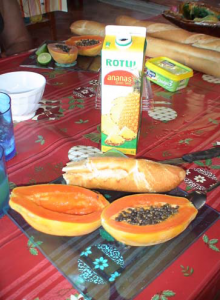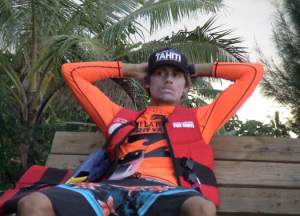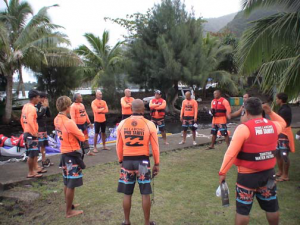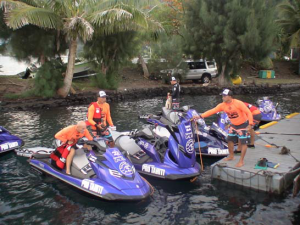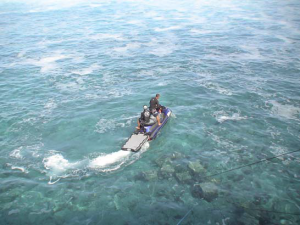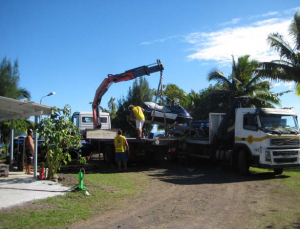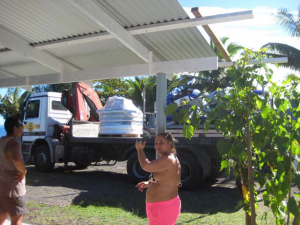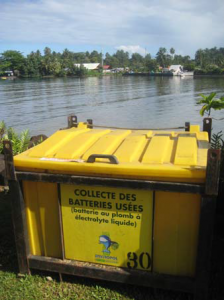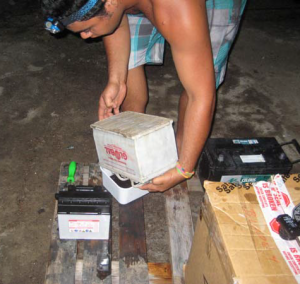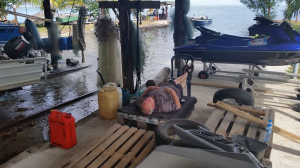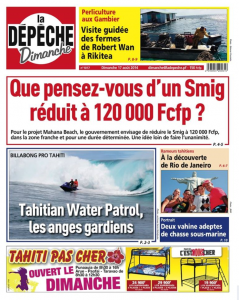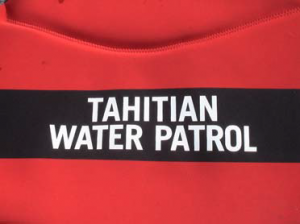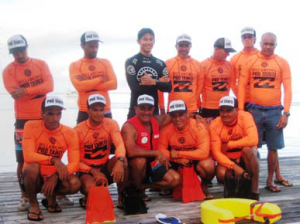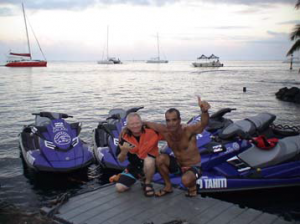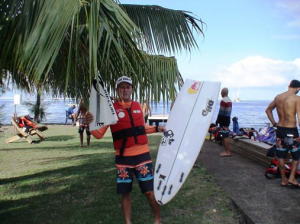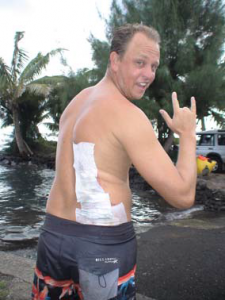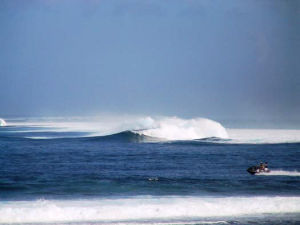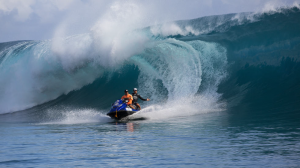2014 ASP Billabong Pro – Teahupo’o, Tahiti
On Assignment with Chris Real
Overview
Since 2009 I have been one of the support team members of an international group of the Association of Surfing Professionals.
The assignment is the “ASP Billabong Pro” in Teahupo’o, Tahiti.
The tower in the lagoon looks out to the reef break wave, “Chopes”. The boats are in the channel and are where people gather to watch he surfing action. Often the reef in front of the tower where the waves break is shallow enough to walk on.
Chris O, the contest director, arrives at about 5:30 AM and rides a watercraft to the outside of the reef and checks the channel and wave conditions.
The Water Patrol guys arrive by 6:00 AM, we have a brief meeting, launch the watercraft and await the call time for the start of the competition.
Typically surfing starts at about 7 AM and concludes at about 5 PM. At the conclusion of each day we pull the watercraft from the ocean and they are flushed, washed, cleaned, serviced and fueled for the next day’s use. On a good “no drama” day my work day ends at about 7 PM. This is the schedule for three weeks.
Working from sunrise to sunset is hard, but being rewarded with the purple sunrise and golden sunsets makes it totally worth it.
I stay in a group house along with the other 8-12 support staff members. Teahupo’o is at the end of the road and really not close to anything other than a very impressive surfing area and a great little fishing village community.

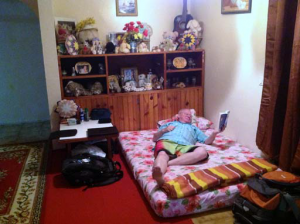
Home sweet home, first class accommodations.
One sort of funny thing, in the evenings after work everyone tries to Skype home to talk with their families. When the web connection is bad (most of the time), all you can hear is everyone yelling “Can you hear me?!!!” – “Turn off the video, WHAT – WHAT – WHAT, Crikey, say it again!!!” It is super funny to listen to the Australians and New Zealanders swear at the computer screen. In place of joining the web challenges, I usually elect to read, compose my notes and relax as often we have after hours things to contend with.
The 2014 Start
August 6, I arrived in Tahiti at 11:00 PM local time, a day and a half later than my scheduled time. This schedule change was not relayed to the local transportation guy, so I rented a car to drive the 40 miles to the village of Teahupo’o. Not a big deal, rained most of the way. When I get there I catch up with my friends and have a Hinano, the potent local beer. I sleep like a log as the flight is 8+ hours, customs takes about 2 hours and the drive to Teahupo’o is an hour and a half.
August 7
I found out that the 6 of the 8 primary emergency watercraft had been delayed in shipping due to the hurricane in Hawaii. I spent the day servicing 4 generators, 4 Yamaha 25 HP outboards, sorting the fuel rig, rigging 3 aluminum boats, and performing a technical inspection of the 3 primary filming boats and reviewing the large diesel base generators that have been brought in to power the satellite up link web broadcast area.
I met with the regional environmental protection officer and fire prevention department about our fueling and service procedures and they had no issues with our fire prevention plan or our environmental protection management setup. Later in the contest they come and visit my wharf often to observe. They are dedicated individuals that balance a wide range of complex challenges.
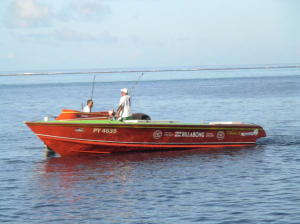

Our filming boats.
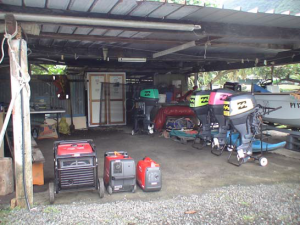
The “REAL” workshop. |
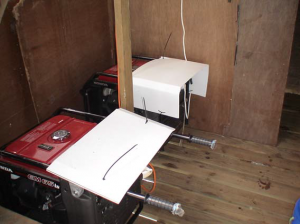
|
August 8
I am getting very worried as a big swell is headed for the surfing area and the qualifying “Trials” start tomorrow! I spent the day setting up the generators at the judging tower for the TV and broadcast cameras. The emergency rescue watercraft finally arrived at 4:00 PM!
Six of the watercraft are new never run and still in the crate, semi disassembled Yamaha 3 seat Wave Runner skis. Two are the smaller “VX” wave runners, 6 are the larger “FX HO” FI turbocharged machines. Two of the larger skis have come directly from another surfing contest where they were they were treated poorly. All of the skis needed servicing and assembly and needed the new rescue sleds fitted. This is typically a 4 hour job per ski! I had help from my Tahitian friends and one of our team members on the uncrating but the mechanical work and precision adjustments are my responsibility.
Prior to having ASP purchase the watercraft I had personally met with and asked the selling dealership to provide me with their PDI check sheet for each ski and to fully service and charge the batteries. I did not think that this was too much to ask seeing that they were selling an 8 pack of expensive watercraft.
Anyway, the crew and I assembled the controls and added fuel and when the battery cables were attached, the batteries were dead! I had the guys put our two battery chargers on the watercraft, and an hour later, still no voltage! Now it is 11:30 PM, and I have 6 absolutely stone dead batteries! We remove the batteries and find that only 2 of the batteries have battery acid (electrolyte) in them and I am in a foreign country, at the end of the road, in a very rural community!!! I say some very harsh things about the dealer’s service manager and mechanic and then I have a minor panic attack.
My Tahitian friends and my teammate “Big Dan” just stand back as I bang my head against the wall, kick dirt, walk in circles and try to come up with a plan. It does not help much when your helpers are all saying “Mate, you are totally wanked!”.
My midnight solution is to drive 1 K up the road to the local marina where I know that oil and battery disposal containers are located. I am in luck as the recycling containers are unlocked. I go “dumpster diving” and come up with 10 -15 junk batteries that still have fluid in them! The marina security guy only wakes up when we have put the old dead batteries in the truck!
We get the batteries back to my workshop, drain them of their acid and fill and charge the new batteries. By 2:30 AM I have 8 running watercraft!
August 9th
I arrive at my workshop at 5:00 AM and the Water Patrol guys help install the rescue sleds at 5:30. We put each watercraft into the water and I have the guys do a 1 hour break in and we do a control check and I give each a quick tune. All is good and the Water Patrol is on the surf line at 7 AM for the start of the Trials. We have one ski fail due to a low battery charge, and I park it until I can do a full system check.
The surf for the Trials is big, 10′ – 16′ with an occasional 20′ wave. The Water Patrol makes some amazing surfer pickups, and one surfer is severely injured when he hits the reef with his head. He is rushed by the water patrol to the marina to the ambulance and transported to the hospital. His injuries are serious with a fractured skull and many deep cuts. Several days later we get good news and learn that he will recover. The trials conclude in one day. During the contest we have some typical minor mechanical issues but nothing serious.
I allowed myself a brief recharge as the 22 hour day was a challenge.
August 10
Everyone on the crew is totally exhausted. During the trials we found some minor glitches in the support equipment as the web and public address people had elected to utilize more equipment than ever. This challenge was addressed by using our extra generators out on the tower. This was an overkill on electrical supply, but it ensured that we had constant power and plenty of reserve and back up. The running of double generators necessitated that the platform where the generators are located be modified for additional air flow, and of course used significantly more fuel so we had to make more pit stops with the supply boat to the tower and to our remote fuel depot. Thanks to our Tahitian partners we do not run short of fuel.
August 11-14
For the next several days I work on giving each of the rescue watercraft a thorough inspection adjust the controls and tune the engines to give the performance needed to function in the unique swift water rescue conditions. (For my motorsports friends, the adjustments are to add anti-stall, increase throttle response on the initial, make it “hit” harder in the low and mid RPM range and add a scoop of traction control / anti- cavitation on the launch.) The Yamaha’s are high performance fuel injected turbocharged models. The Tahitian gasoline is not exactly a “high performance” blend, and water in the fuel is always a problem. I have Maurice, our excellent supply guy get me some electrolyte and some supplies and I change out the recycled fluid and do several charge / drain and load test cycles on the batteries. All good and we are ready. (This turns out to be a very good thing.)
During the setup days the work crew and I work long days getting the area setup. Some of the preparation activities are media functions and advanced training with the medical staff and Water Patrol. The medical staff are world class trauma specialists and the training is beneficial to all of us. The local newspaper reporter comes to Teahupo’o and does a story about the swift water rescue team of the Tahitian Water Patrol (http://www.aspworldtour.com/posts/62025/tahiti-water-patrol-patrice-chanzy-interview). The rescue response that they did of the injured surfer during the Trials was amazing and it was shown on the local TV news. As part of the Water Patrol I was interviewed about the machines and our environmental activities. Having the article in the Sunday paper helped my relationship with the local fire and environmental protection officers, and as always I enjoyed their visits to the wharf.


The Water Patrol guys say that since I am a full Tahitian Water Patrol member it is my turn to buy the beer!
August 12 – 15
The weather is good, but hot, about 90° and the sun is very intense. We are all tired and my good friend, “Big Dan” starts feeling very bad. At first he says that he has a cold, then he says he aches all over. He has chills, then a fever. He takes a few hours to rest, but is getting worse by the hour. The next day he works but has to take frequent rests, and does not improve. Our team leader, Danny and I are keeping a close eye on Dan’s health. At about 1 AM we rush Dan to the “Urgency Room” at the local hospital. They give Dan a checkup, he has a severe ear infection. They take some blood and tell us that he has a local tropical virus. Dan is given medication, is told to stay in the dark and he cannot work. After a few days Dan improves and when he is stable, departs. We learn that Dan makes it back to Australia but checks into the hospital for additional care. A few days after Dan’s bad health situation another of our work group, Maurice becomes ill. He is also diagnosed with the tropical virus, and spends the remainder of his stay in bed or doing trips to the clinic. We had another of the team visit the clinic with an infection from a minor cut.
August 15 – 28
We have a period of inconsistent waves and for a few days the surfing contest is minimized to let the weather clear and to wait for a large swell that was making it’s way across the Pacific and headed our direction. Even on the non official contest days many people and participants surf and practice.
The waves on the off days gave surfers and the Water Patrol a work out. On one day I counted 10 broken surfboards leaving the channel, and “reef rash” was always present.
Waiting on the swell was an excellent decision from ASP as the waves for the contest were extraordinary, and made for one of the best surfing contests ever. Photos and videos are viewable on the ASP world tour website(http://www.aspworldtour.com/posts/62495/live-blog-billabong-tahitipro).
My trip was filled with challenges and I never had the chance to leave Teahupo’o, other than to go to the hospital, local hardware store and then back to the airport to fly home.
If this sounds like the assignment was no fun and all work, think again. Tahiti is magnificent and the people and culture are fantastic.

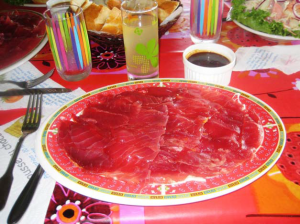
Everyone wants to know what we did with a 130 pound Tuna……
n
